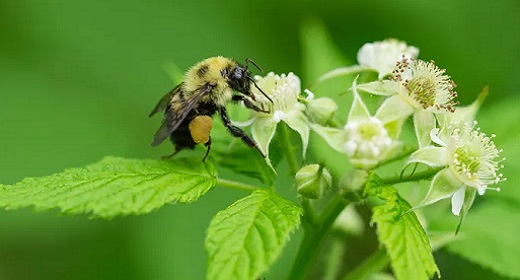Farmers have long been part of the sharing economy. They might lend tractors or other heavy pieces of equipment to help neighboring farms and can be quick to offer a hand when necessary.
Now research suggests they might want to share on a much smaller scale … with wild bees.
Native bees are essential pollinators for many crops, but creating habitat for wild bees on farms uses up valuable planting space. Farmers don’t always want to dedicate land strictly for bees when their crops can be pollinated by a neighbor’s bees.
Researchers from the University of Minnesota and the University of Vermont worked in the fields of California’s Central Valley, one of the country’s busiest agricultural areas. They analyzed crop values, land ownership patterns, and bee ecology to determine the benefits of creating bee habitats for landowners. In Yolo County, for example, crops like berries and nuts that are dependent upon bees for pollination are worth thousands of dollars per acre. Every inch of land is valuable to farmers.
“The motivation for our specific work was to address the question: Under what circumstances is it worth it for a farmer to invest in habitat for wild bees? Related to this, do patterns of land ownership affect this calculus?” Eric Lonsdorf, lead scientist for the Natural Capital Project at the University of Minnesota’s Institute on the Environment and lead author of the study, tells Treehugger.
“While society knows that bees are critical for our food supply, it is ultimately an individual farmer who decides how to manage their land. If we, as a society, are to become more sustainable, we must be able to understand the challenges of aligning individual goals and constraints with those of society. Pollination provides one example on how to address this larger question.”
Creating a Bee Habitat
Creating a habitat for wild bees on farms doesn’t have to be a large undertaking. Landowners can simply let a small bit of land stay wild amid the crops so bees can find a familiar haven among the plants. But it can be difficult for farmers to find the incentive in giving up valuable planting land in exchange for wild habitat, the researchers point out.
The payoff, however, was great, they found. If 40% of landowners were to provide space for wild bee habitat, those landowners would lose $1 million dollars themselves, but generate nearly $2.5 million for their neighbors.
“I think what was most surprising was not the money provided by bees as there are studies that have attempted to show the overall value of pollinations — for example a 2009 global estimate was approximately $150 billion. What was surprising was that 40% of landowners would not do this on their own if only their costs and benefits were considered,” Lonsdorf says. “This scale of missed opportunity was surprising and shows just how important it is for landowners to work together. It is important to note that we did not include the value for honeybees in our analysis — we focused on the potential for wild bees to contribute.”
The study was published in the journal People and Nature.
Lonsdorf says the results can provide a road map for how farms can identify opportunities for cooperative management of bee habitat.
“In many areas, cooperative watershed management exists with the knowledge that people share watersheds and that individuals must work collectively to manage the entire watershed,” he says. “Our work provides clear demonstration that cooperatively managing a ‘bee-shed’ can be done in a similar way. Groups of farmers could agree to set aside some land as a collective investment.”
It may not always be a smart choice for every farmer to convert land to bee habitat.
“Our analysis illustrates that if a farmer has very valuable crop, it doesn’t make sense to convert it to bee habitat, but if the potential value one owner provides another could be recognized, it would simply make sense for some landowners to supply wild bees to others that need them,” Lonsdorf says. “In other words, the per acre value of bees would be greater than the per acre value of the current land. So simply providing farmers the information should help them make this decision.”
















































